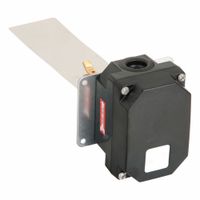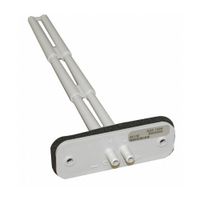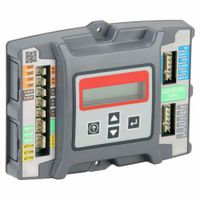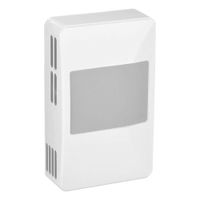Call +(254) 703 030 000 / 751 483 999 / 721 704 777
- Home
- Hvac And Refrigeration
- Hvac Controls And Thermostats
- Hvac Sensors Switches
.....Read More
Frequently Asked Questions
What are the different types of HVAC sensors and switches?
HVAC systems utilize a variety of sensors and switches to ensure efficient operation and maintain desired environmental conditions. Key types include:
1. **Temperature Sensors**: Measure air or surface temperatures. Common types are thermistors, thermocouples, and resistance temperature detectors (RTDs).
2. **Humidity Sensors**: Also known as hygrometers, these measure the moisture content in the air, crucial for maintaining comfort and preventing mold growth.
3. **Pressure Sensors**: Monitor the pressure of gases or liquids within the system. They are essential for ensuring the correct operation of compressors and other components.
4. **Air Quality Sensors**: Detect pollutants, CO2 levels, and volatile organic compounds (VOCs) to maintain indoor air quality.
5. **Occupancy Sensors**: Detect the presence of people in a space to adjust heating, cooling, and ventilation accordingly, enhancing energy efficiency.
6. **Flow Sensors**: Measure the flow rate of air or liquid, ensuring that the system operates within its designed parameters.
7. **Smoke Detectors**: Essential for safety, these sensors detect smoke and can trigger alarms or shut down the HVAC system to prevent the spread of smoke.
8. **Level Sensors**: Monitor the level of liquids, such as refrigerants or condensate, to prevent overflow or ensure adequate supply.
9. **Thermostats**: Act as both sensors and controllers, maintaining the desired temperature by switching the HVAC system on or off.
10. **Limit Switches**: Ensure components operate within safe limits, shutting down the system if temperatures or pressures exceed safe thresholds.
11. **Differential Pressure Switches**: Used in air handling units to monitor filter conditions and airflow, indicating when maintenance is needed.
These sensors and switches work together to optimize HVAC performance, enhance energy efficiency, and ensure safety and comfort.
How do temperature and humidity sensors work in an HVAC system?
Temperature and humidity sensors in an HVAC system work by detecting and measuring the environmental conditions to maintain optimal indoor air quality and comfort.
Temperature sensors, often thermistors or thermocouples, measure the ambient air temperature. Thermistors change resistance with temperature changes, while thermocouples generate a voltage proportional to temperature differences. These sensors send data to the HVAC control system, which adjusts heating or cooling outputs to maintain the desired temperature setpoint.
Humidity sensors, or hygrometers, measure the moisture content in the air. Capacitive humidity sensors are common, consisting of a hygroscopic dielectric material between two electrodes. As humidity changes, the dielectric constant changes, altering the capacitance, which is then converted into a humidity reading. Alternatively, resistive humidity sensors use a moisture-sensitive material whose resistance changes with humidity levels.
In an HVAC system, these sensors provide real-time data to the central control unit. The system uses this information to regulate air conditioning, heating, and ventilation components. For instance, if the temperature sensor detects a drop below the setpoint, the system activates the heating element. Similarly, if the humidity sensor indicates high moisture levels, the system may increase ventilation or activate a dehumidifier to reduce humidity.
By continuously monitoring and adjusting based on sensor data, HVAC systems ensure energy efficiency, prevent mold growth, and maintain comfort. These sensors are crucial for automated climate control, allowing for precise adjustments and improved indoor air quality.
What is the role of pneumatic temperature transmitters in HVAC systems?
Pneumatic temperature transmitters play a crucial role in HVAC (Heating, Ventilation, and Air Conditioning) systems by providing accurate temperature measurement and control, which is essential for maintaining desired environmental conditions. These devices convert temperature readings into a proportional pneumatic signal, typically ranging from 3 to 15 psi, which is then used to control various HVAC components such as dampers, valves, and actuators.
The primary function of pneumatic temperature transmitters is to ensure precise temperature regulation within a space. They achieve this by continuously monitoring the ambient temperature and sending a corresponding pneumatic signal to the control system. This signal is used to adjust the operation of heating or cooling equipment, ensuring that the temperature remains within the set parameters.
In addition to temperature regulation, pneumatic temperature transmitters contribute to energy efficiency. By providing accurate temperature data, they enable the HVAC system to operate only when necessary, reducing energy consumption and operational costs. This is particularly important in large commercial or industrial settings where energy efficiency can lead to significant cost savings.
Moreover, pneumatic temperature transmitters are known for their reliability and durability, especially in environments where electronic devices might be susceptible to interference or failure. They are often used in older buildings or facilities where pneumatic control systems are already in place, providing a cost-effective solution for temperature control without the need for extensive system upgrades.
Overall, pneumatic temperature transmitters are integral to the effective operation of HVAC systems, ensuring comfort, energy efficiency, and system reliability.
How do air quality sensors improve indoor air quality?
Air quality sensors enhance indoor air quality by providing real-time monitoring and data analysis, enabling proactive management of pollutants. These sensors detect various contaminants such as particulate matter (PM2.5 and PM10), volatile organic compounds (VOCs), carbon dioxide (CO2), carbon monoxide (CO), and humidity levels. By continuously measuring these parameters, sensors offer insights into the air quality status, allowing for timely interventions.
When air quality sensors identify elevated levels of pollutants, they can trigger ventilation systems to increase airflow, thereby diluting and removing contaminants. This automated response ensures that indoor environments maintain healthy air quality without manual intervention. Additionally, sensors can be integrated with HVAC systems to optimize their operation, reducing energy consumption while maintaining optimal air quality.
Data collected by air quality sensors can be analyzed to identify patterns and sources of pollution, such as cooking, cleaning activities, or external pollution ingress. This information helps in implementing targeted strategies to mitigate specific sources, such as improving ventilation in kitchens or sealing windows to prevent outdoor pollutants from entering.
Moreover, air quality sensors raise awareness among occupants about the importance of maintaining good air quality. By providing visible feedback through displays or mobile apps, they encourage behavioral changes, such as reducing the use of VOC-emitting products or increasing natural ventilation.
In commercial settings, maintaining good indoor air quality can enhance employee productivity and reduce health-related absences. In residential environments, it contributes to the well-being and comfort of occupants, particularly those with respiratory conditions or allergies.
Overall, air quality sensors play a crucial role in maintaining healthy indoor environments by enabling informed decision-making, optimizing ventilation, and promoting awareness and behavioral changes.
What is the function of air pressure sensors and switches in HVAC systems?
Air pressure sensors and switches in HVAC systems play crucial roles in monitoring and controlling the system's performance and safety.
Air pressure sensors measure the pressure of air within the HVAC system, providing real-time data to the system's control unit. This information is used to ensure that the system operates within its designed parameters, optimizing efficiency and performance. By monitoring air pressure, these sensors help in detecting issues such as blockages, leaks, or system malfunctions, allowing for timely maintenance and preventing potential damage.
Air pressure switches, on the other hand, are used to control the operation of various components within the HVAC system based on the detected air pressure levels. They act as safety devices, ensuring that the system operates only when the pressure is within safe limits. For example, a pressure switch might prevent a fan from operating if the pressure is too low, indicating a blockage or a closed damper, which could lead to overheating or damage.
Both sensors and switches contribute to energy efficiency by ensuring that the system operates only when necessary and at optimal conditions. They also enhance safety by preventing the system from operating under potentially harmful conditions. Additionally, they help in maintaining indoor air quality by ensuring proper airflow and ventilation.
In summary, air pressure sensors and switches are integral to the efficient, safe, and reliable operation of HVAC systems, providing critical data and control functions that help maintain system integrity and performance.
How do airflow switches operate within an HVAC system?
Airflow switches in HVAC systems are devices used to monitor and control the flow of air within the system. They operate by detecting the presence or absence of airflow and sending a signal to the system to take appropriate action, such as shutting down equipment or triggering an alarm.
The operation of an airflow switch typically involves a sensing element, such as a vane, paddle, or diaphragm, which is placed in the path of the airflow. When air moves through the duct or system, it exerts force on the sensing element. This force causes a mechanical movement or pressure change that is detected by the switch.
There are two main types of airflow switches: mechanical and electronic. Mechanical switches use a physical movement to activate a contact, while electronic switches use sensors to detect changes in pressure or flow and send an electronic signal.
In a mechanical airflow switch, the airflow moves a vane or paddle, which is connected to a spring-loaded mechanism. When the airflow reaches a certain threshold, the vane moves enough to actuate a switch, closing or opening an electrical circuit. This action can trigger a response, such as turning off a fan or activating an alarm.
Electronic airflow switches use pressure sensors or thermal sensors to detect changes in airflow. Pressure sensors measure the differential pressure across a known restriction, while thermal sensors detect changes in temperature caused by airflow. These sensors send signals to a control unit, which processes the information and takes necessary actions.
Airflow switches are crucial for ensuring the safe and efficient operation of HVAC systems. They help prevent damage to equipment, maintain indoor air quality, and ensure compliance with safety standards by providing real-time monitoring and control of airflow conditions.
What are economizers and how do they enhance HVAC efficiency?
Economizers are devices integrated into HVAC systems to enhance energy efficiency by utilizing outdoor air to reduce the need for mechanical cooling. They work by taking advantage of favorable outdoor conditions, such as cooler temperatures, to provide free cooling to a building, thereby reducing the load on the HVAC system.
There are two main types of economizers: air-side and water-side. Air-side economizers bring in outside air when it is cooler than the indoor air, mixing it with return air to achieve the desired indoor temperature. This process reduces the need for mechanical cooling, as the cooler outdoor air can be used to maintain comfortable indoor conditions. Water-side economizers, on the other hand, use cooling towers to cool water, which is then used to cool the air inside the building, bypassing the chiller.
Economizers enhance HVAC efficiency by reducing energy consumption and operational costs. By using outdoor air for cooling, they decrease the reliance on compressors and chillers, which are energy-intensive components of HVAC systems. This not only lowers electricity bills but also extends the lifespan of the equipment by reducing wear and tear. Additionally, economizers can improve indoor air quality by increasing ventilation rates, which helps dilute indoor pollutants.
In summary, economizers optimize HVAC performance by leveraging natural cooling opportunities, leading to significant energy savings and improved system longevity. They are particularly effective in climates with significant temperature variations between day and night or across seasons, where outdoor air can frequently be used for cooling.





